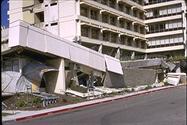Poor seismic performance of concrete buildings has been demonstrated dramatically in recent earthquakes around the world, as well in the U.S.’s moderate Northridge earthquake of 1994. Unfortunately, few building officials in the major metropolitan areas of the western U.S. and Canada know how many of these buildings there are in their jurisdictions. The potential safety problems posed by some concrete buildings constructed in the U.S. west coast prior to the 1970’s are generally well known among structural engineers and building officials practicing in seismically active areas. Public policy makers are somewhat less aware and the general public is not informed adequately of the potential risks. A scenario based on a repeat of the San Francisco 1906 event in the San Francisco Bay Area today confirms that a large proportion of the deaths and serious injuries would be attributable to the collapse of nonductile concrete buildings.
These buildings are widespread. They were a prevalent construction type in the western U.S. prior to enforcement of codes for ductile concrete in the mid-1970s. The exposure to life and property loss in a major earthquake is immense. Many nonductile concrete buildings have high occupancies, including residential, commercial, and critical services. Severe damage can lead to critical loss of building contents and risk of ruin for business occupants and partial or complete collapse can result in large numbers of casualties.
The Concrete Coalition is generating a concerted effort to advocate the identification of these dangerous concrete buildings and the development of sensible solutions to reduce risks associated with these buildings. This network of local volunteers is working with heavily populated counties on the U.S. west coast that have a significant seismic risk, and is assembling data in an organized format to be placed in a website database for dissemination. In addition to the “digital” network of information, this approach will create a human network comprised of all those who contribute. This will facilitate future cooperation and solidarity as local communities update/prepare mitigation plans and strategies to reduce the risk associated with these buildings.

